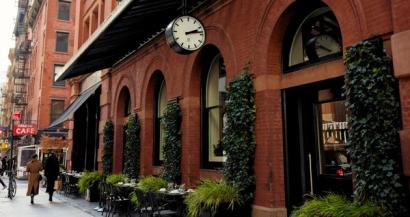
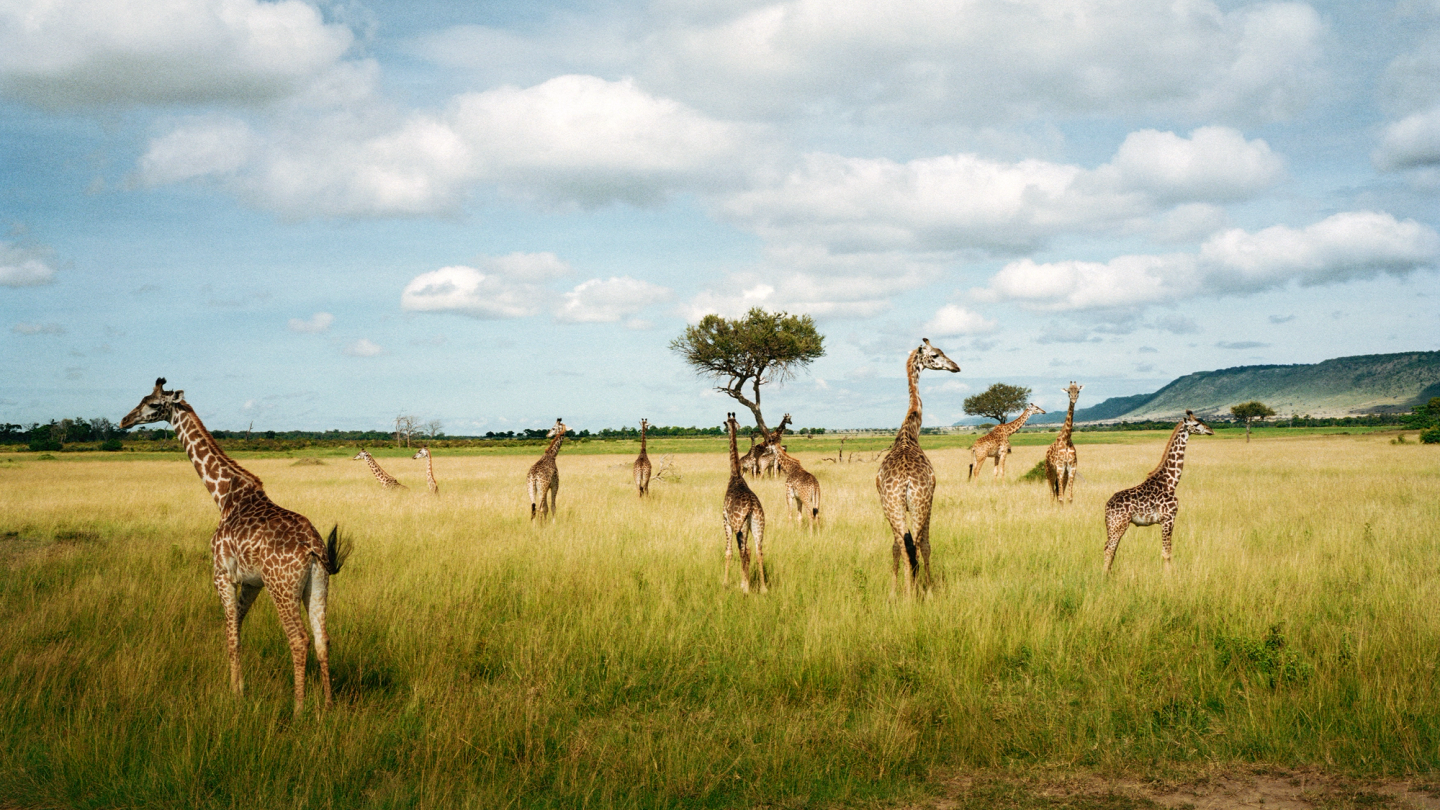
This side of paradise
Photojournalist Guillaume Bonn presents a haunting requiem for the African continent – an earthly paradise which is fighting for its survival against the advancements of industry and tourism
Words: Jon Lee Anderson
Photography: Guillaume Bonn
Paradise Inc. is the result of a decades-long quest by Guillaume Bonn to witness, and to document, the final days of the great east African wilderness. What this book contains, in his photographs and his words, is the consequence of many trips across many years into the African bush as well as the continent’s towns and cities.
A third-generation French ‘African’, Guillaume was born in Madagascar and grew up in the Comoros, in Djibouti, and in north Yemen, but it was in Kenya where he lived the longest and spent his most formative years – the place where, as he puts it, he formed his “ideas and opinions of nature and of life”. It is a place he has returned to and lived for extended periods throughout his life. As a working documentary photographer across the past three decades, in Kenya and elsewhere in Africa, Guillaume has been a first-hand witness to its enduring glories and its ongoing traumas, which range from its extraordinary range of human and wildlife diversity to its wars and famines and atrocious poverty. For better or worse, this is the Africa that has become his inescapable muse, a place that compels him and repels him. It’s a bond that he describes as “le mal d’Afrique”.
A Garamba Park ranger in the Democratic Republic of Congo posing with an elephant’s tusk
As a friend and colleague of Guillaume’s with a shared passion for Africa, I have watched as this book has taken shape during the years; it has also been the subject of many discussions on several journeys we took together in Kenya and Tanzania. Guillaume’s purpose on these trips was to show me some of the endangered wilderness areas he knew, and to introduce me to some of the people he most admired, people who were dedicating their lives to help preserve what remained: Richard Bonham, Paula Kahumbu, Ian Craig, the late Tony Fitzjohn and Richard Leakey.
Many of the changes that are taking place today in Africa are catastrophic ones. Armed conflicts, soaring human population increases and rapidly expanding urban development have already degraded many wilderness areas and have altered the traditional coexistence between human and wildlife. Just as some of the continent’s traditional human cultures are vanishing in the face of urbanisation, many of its animal species are critically endangered. The onset of climate change has accelerated both the pace and the effects of these changes, leading to an urgent existential question: how much longer will the extraordinary natural environments and unique ecosystems of east Africa be able to survive?
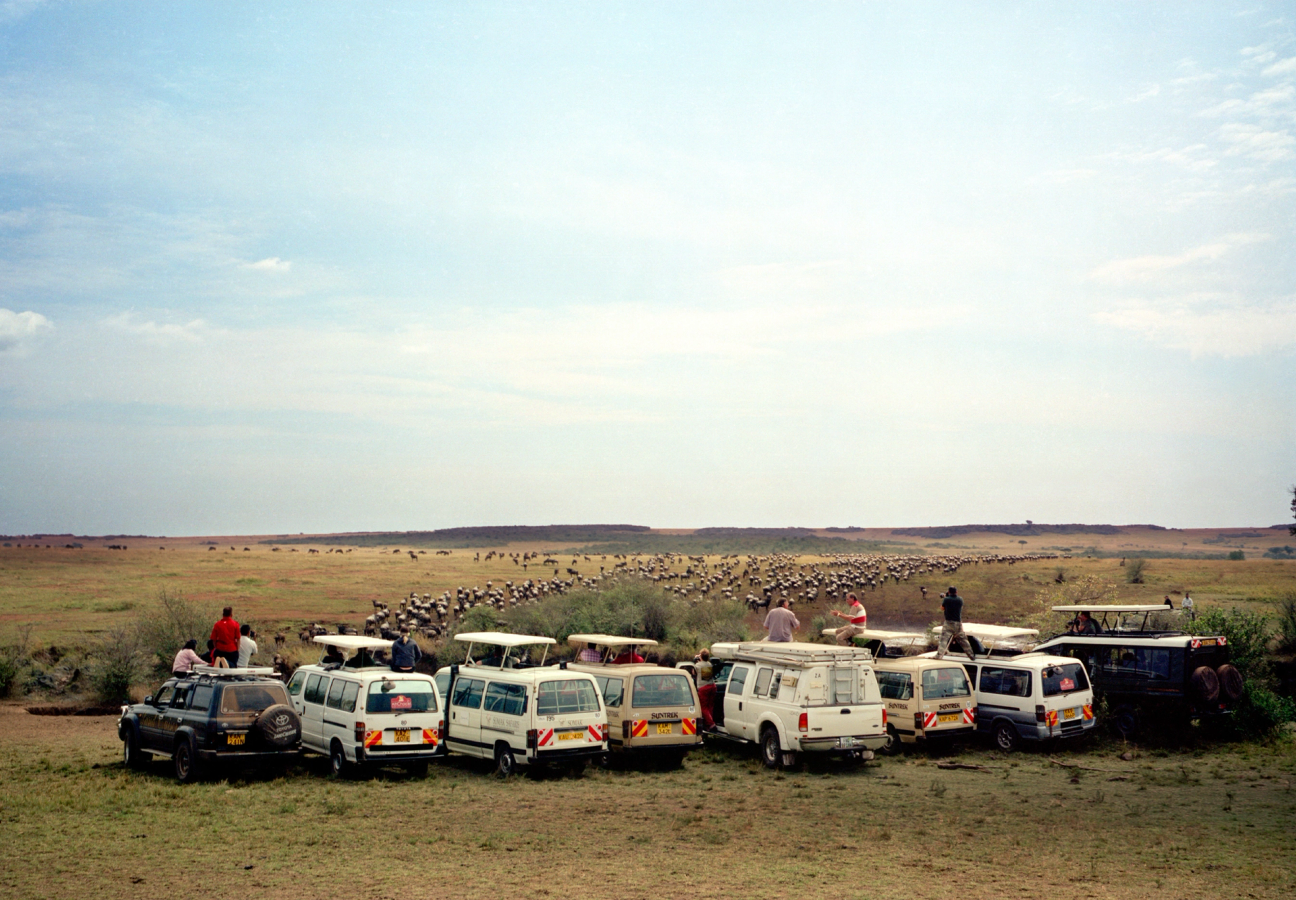
A Garamba Park ranger in the Democratic Republic of Congo posing with an elephant’s tusk
In a meeting Guillaume and I had with him in 2021, a year before his death, the renowned paleoanthropologist and conservationist Richard Leakey shared his belief that most of Kenya’s wildlife was unlikely to survive much beyond the middle of the century. The glaciers on Mount Kenya were melting, the rivers were drying up and the country’s human population, which had quintupled in 50 years, was set to double again by the middle of the century. The next 30 to 50 years would be decisive, he said. “Overall, I’m in a very pessimistic short-to-mid-term attitude,” he said. “I am not persuaded of the prospects for wildlife unless something gives, and I don’t see it.”
Leakey’s assessment was devastatingly bleak, but it had the unwelcome ring of truth. Of course, east Africa’s natural environment has been under threat for a very long time. It was 60 years ago that Peter Beard wrote his unforgettable book, The End of the Game, with its various iterations published across the decades since. Documenting what he saw around him in the late fifties and early sixties, Beard was able to foresee the apocalyptic decline of the great east African elephant population; he accurately predicted an end to the age-old habitats and migration routes that had allowed them and the region’s other remarkable wildlife species to coexist with humans since before recorded time. Beard’s perceptions had a profound impact on Guillaume, who came to know him well, and worked closely with him when he was in his twenties. (Indeed, Guillaume was with Beard when he was trampled and almost killed, by a charging elephant, in 1996.)
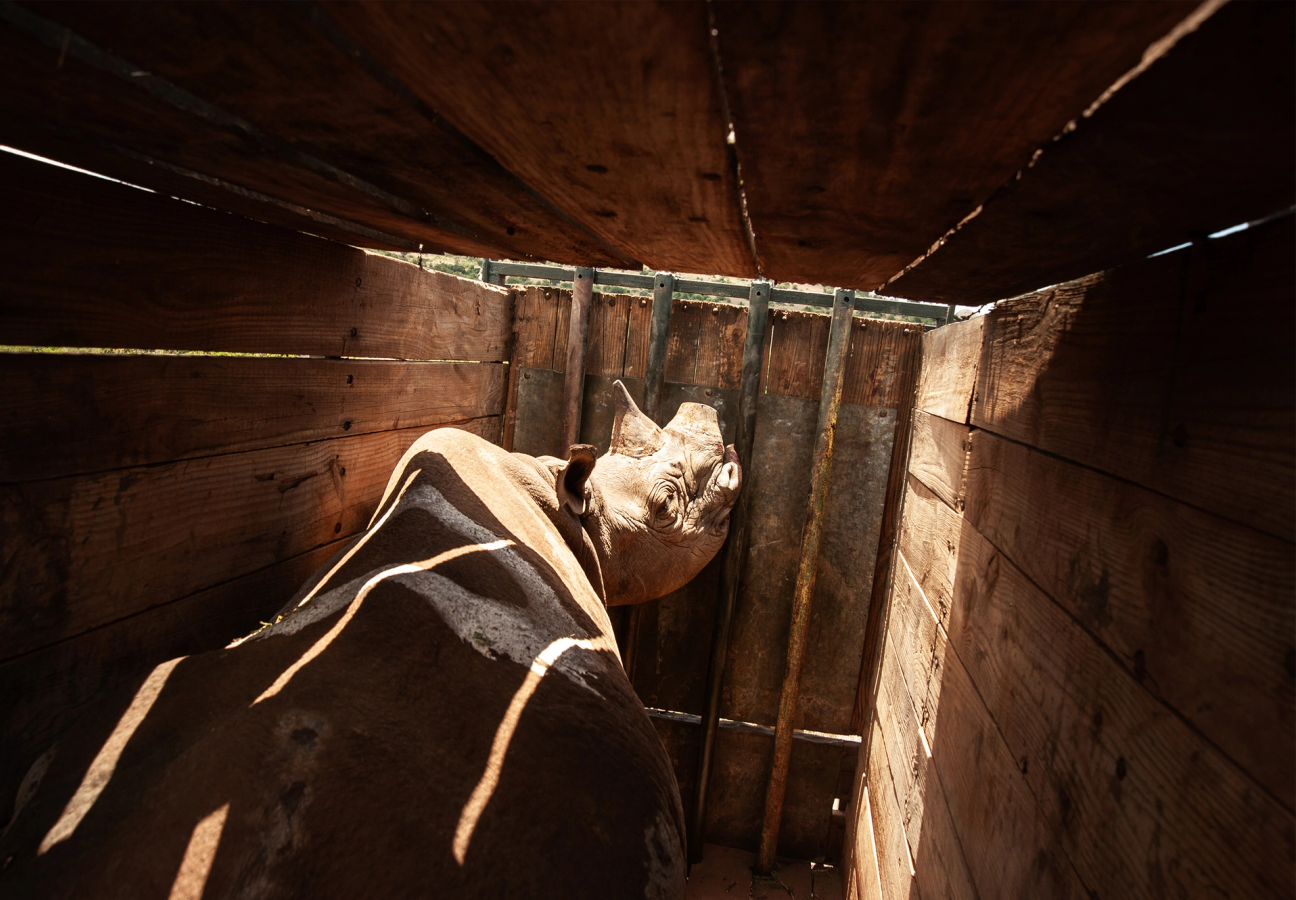
A rhino is being translocated to a new area to avoid deadly territorial fi ghts as its habitat shrinks
Since the publication of Beard’s magnum opus, the standoff between man and nature in East Africa has not merely continued, it has exploded, to the extent that human society competes directly with the remaining wildlife and the natural habitats they depend upon for their survival. Wilderness areas are no longer limitless expanses, but patchworks of separate enclaves, increasingly shared with the relentlessly advancing farms, towns, cities, factories and roads being built by human beings. How to balance it out and allow for human growth while also rescuing the animals and their habitat for almost certain extinction? A photograph taken by Guillaume of an elevated railroad bridge cutting through Nairobi National Park, a herd of zebras grazing in the elephant grass around its pillars, may be one glimpse of the looming future.
By making Paradise Inc. the title for his book, Guillaume is reaffirming that east Africa truly is an earthly paradise. Just as the Paradise that is the mythical realm of most of the world’s major religions, he is saying, this region, in all its wondrous beauty and diversity, is a real-life repository for our collective sense of natural perfection, and a glimpse of temporal eternity. But just as determinedly, however, Guillaume wishes us to see the fragility of that paradise, the future of which now hangs in the balance. That is where the “Inc” comes in.
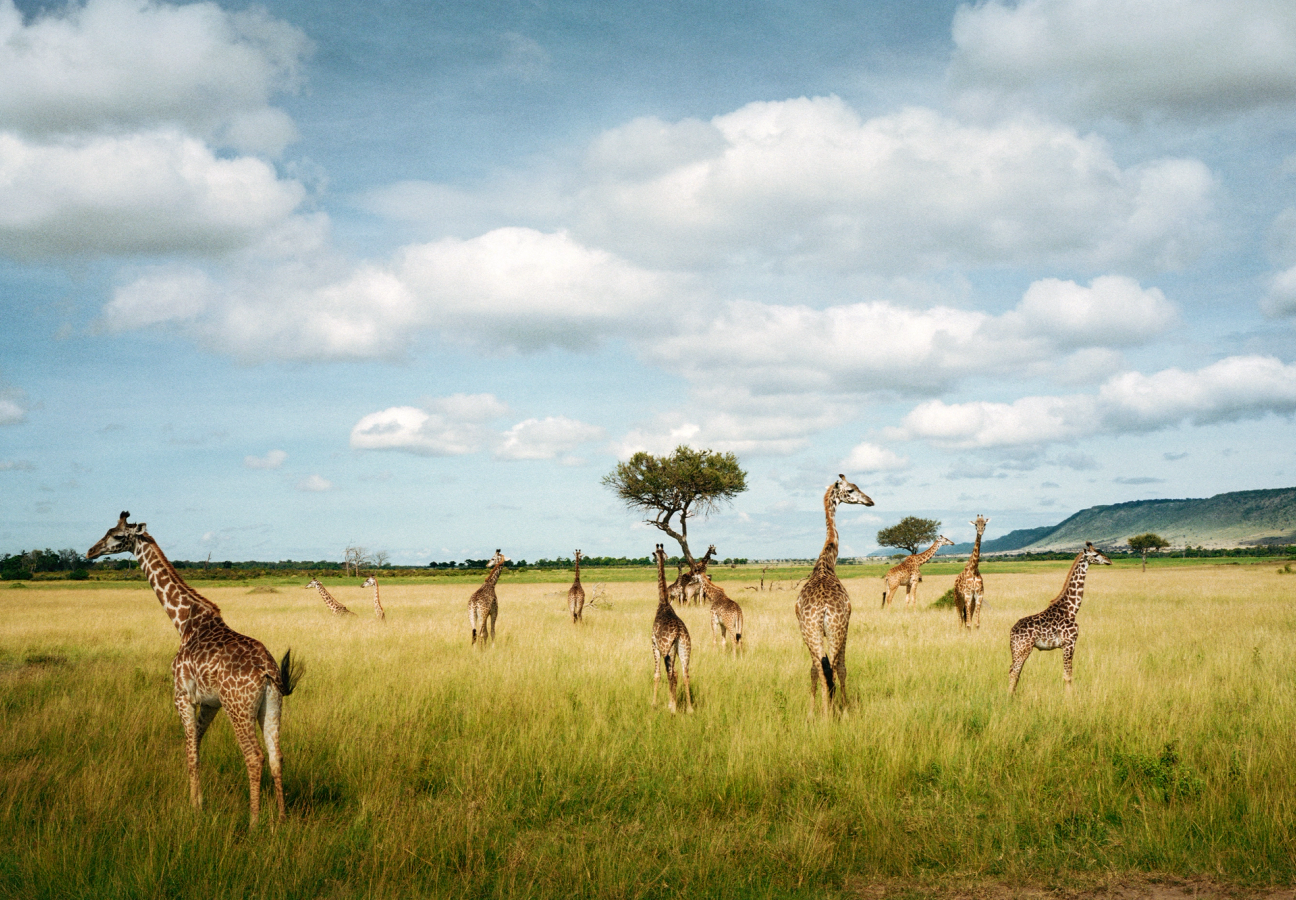
The Maasai Mara Game Reserve is a large nature reserve located in southwestern Kenya, near the Tanzanian border. It is part of the larger Mara-Serengeti ecosystem, which spans both Kenya and Tanzania
Guillaume inveighs, understandably, against the amoral profiteering and outright cruelty of the poachers of rhino horn and elephant ivory, but he also reserves contempt for the modern class of white-collar profiteers who build hotels on the very edges of national parks and engineer ‘safari experiences’ for the foreign tourists who flock to places such as Kenya’s Maasai Mara. He reserves sharp words, as well, for those visitors who choose not to see the harsh realities that lie beyond their exclusionary zones, such as the shantytowns that ring the national parks they have paid handsomely to ‘explore’ for a few days at a time. And if any of them wonder about the effects of their presence on the wildlife they have come to see in their luxurious Land Cruisers, or what happens to the rubbish that accumulates during their expensive safaris, Guillaume has some indelible reminders for them here.
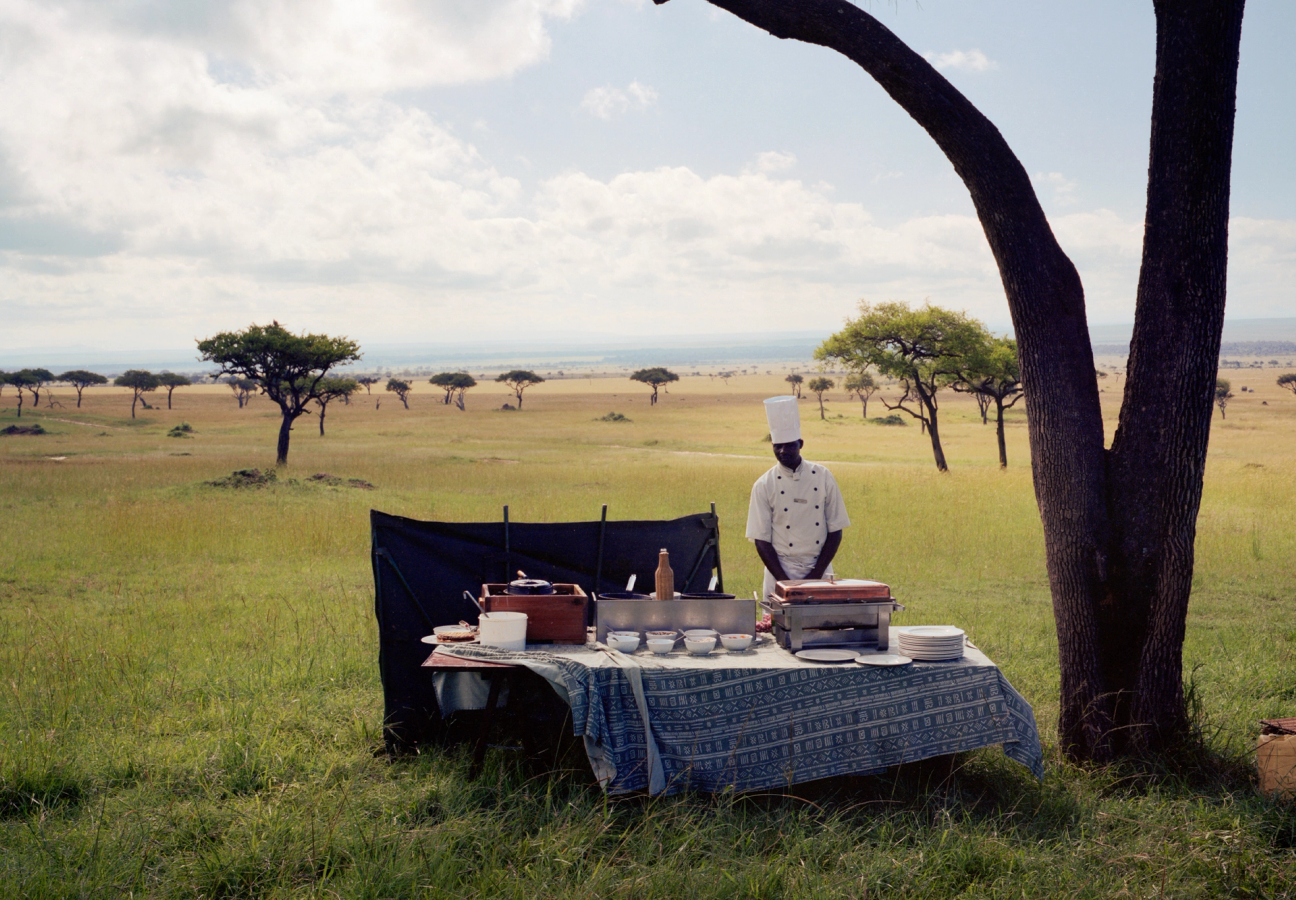
A chef employed by a neighbouring lodge is preparing breakfast for clients who are soon to return from their early morning hot-air balloon ride
In the end, Guillaume is saying that it is no longer possible to frame our perceptions, in the way photographers do, by selecting certain realities and excluding others, to suit our longstanding illusions. The time has come to face the facts, as east Africa’s age-old natural landscapes and wildlife habitats inexorably disappear. Paradise Inc. is therefore a requiem, and perhaps even an epitaph, but it is also a personal plea by Guillaume for the book’s readers to shake off their illusions and to see things as they really are, before it really is too late.
Paradise Inc. is not all lamentation. This book is also an ode to a land that gave birth to Guillaume and that has inspired him. There are beautiful images here. His framing of an east African river valley at dawn is unforgettable, something like everyone’s idea of the Garden of Eden. There we have Guillaume’s almost mystical vision of a wild Africa that is resplendent, before it became an Instagrammable image for the Financial Times’s “How to Spend It” readers.

A lion in a quarry where materials are extracted for the construction of accommodations located just beyond the boundaries of the Maasai Mara Reserve
Guillaume Bonn is a white African of European descent, and for that very reason, he feels inevitably displaced and excluded from some of Africa’s newer realities. It is an insurmountable condition. In Guillaume’s tetchy disquiet about the changes in Africa and his concerns for the future, I am reminded of another white African – the Ethiopian-born British explorer, writer and oddball naturalist Wilfred Thesiger.
Born seven decades before Guillaume, Thesiger too railed against the encroachment of modernity and the destruction of Africa’s old ways. Something his biographer, Alexander Maitland, wrote about Thesiger could easily apply to Guillaume: “Thesiger’s impossible dream had been to preserve the near-idyllic life he had known as a boy in Abyssinia. He viewed change dismally, as a threat to the tribal people he admired, and to himself as a traditionalist and romantic who ‘cherished the past, felt out of step with the present, and dreaded the future’. Such a reactionary outlook was doomed from the start and Thesiger knew it...”

The great migration entails the aweinspiring movement of over a million wildebeest from Tanzania’s Serengeti to the adjacent Maasai Mara reserve in Kenya
Just as Thesiger’s own photographs served as iconic glimpses of an Africa as it had been forever, before the ructions and paraphernalia of the 20th century began to crush it, Guillaume’s own camera lens steadies itself accusingly upon the ongoing erosion, such as a little pile of trash in the forest on the Maasai Mara; a magnificent lion at repose amid an uneven bit of bulldozed waste ground; a newly installed gasoline pump, ready to spring into life on a roadside inexorably running through the Kenyan savannah.
It is as if Guillaume is a kind of detective, in a sense, working for the prosecution, seeking out visual evidence of the crimes being committed everywhere, all around us. As he points out these scenes, his photographs ask us to see it for ourselves, and, perhaps, to do something about it. “I am just a photographer, just an observer,” says Guillaume, but what he depicts is powerful, and his message is clear.
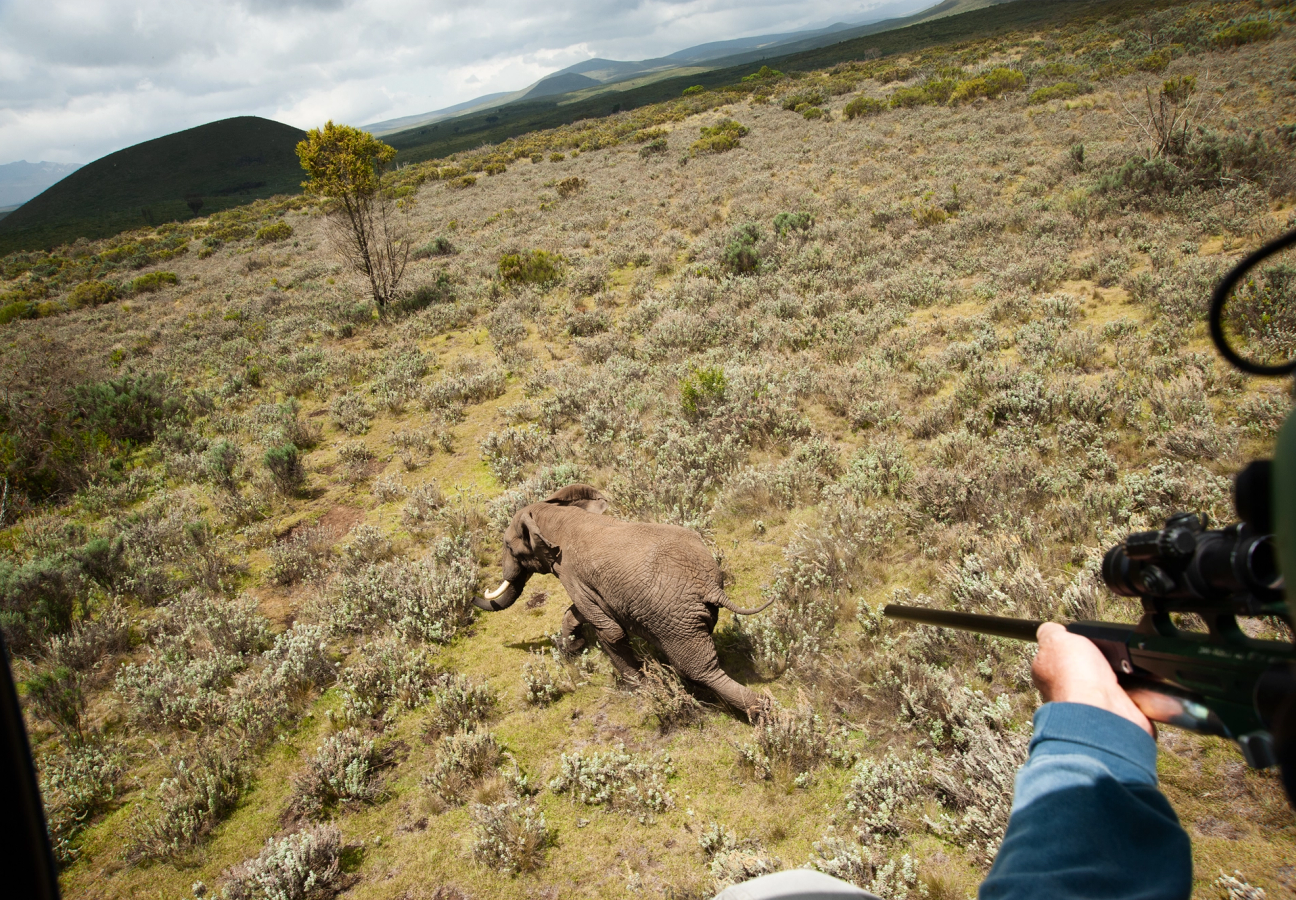
A male elephant on the eastern slopes of Mount Kenya will soon be tranquilised from a moving helicopter and fi tted with a GPS collar
The fact is that Africa, which was the last region in the world to be colonised, in the Scramble for Africa at the tail end of the 19th century, is still the continent with the wildest remaining spaces. But now, little more than a century later, we are seeing those wild spaces finally overwhelmed as the African population surges – it is expected to double in the coming decades. But even now, Africa continues to be romanticised, fetishised and ultimately objectified by outsiders, and by those who seek to profit from those misconceptions. In Paradise Inc., Guillaume Bonn seeks to clear up the cognitive dissonance.
The clarity of perception demanded of us by Guillaume is a bittersweet one. For some reason, an anecdote comes to mind: a few years ago, on a trip to Kenya, Guillaume and I were returning to Nairobi after a few days spent in the Chyulu Hills, a wildlife reserve in the middle of Maasai country. After some hours, we reached the tarmacked highway that runs from the Indian Ocean port of Mombasa to Nairobi. Along the way, new human settlements had popped up along the roadsides. They were not unlike the messy commercial strips that festoon roads the world over – only here they were just getting started, and the savannah that extended to the horizons beyond still had antelopes grazing visibly in the near distance. The land had not yet been carved up; it was still unfenced, but that would happen soon. Trucks carrying cargos from the coast to the capital roared noisily passed us, constantly, feeding the country’s growing population.
To deter poaching, some conservationists have turned to dehorning rhinos. By removing their horns, rhinos become less attractive targets for poachers, as the horns are highly valued on the black market
At one point, a zebra lay dead on its side, next to the passing traffic. It was just there, a relic of the wild, amid the gathering mess that people create with their roads and vehicles and buildings. It was a sad sight, of course, but also, somehow, a thrilling one. After all, it was not just any dead animal but a zebra, a most extraordinary creature, and a reminder that in Africa, the wild, though endangered, still existed.
Purchase Guillaume's book here.
For more photography inspiration, discover Théo Gosselin's favourite shots...


